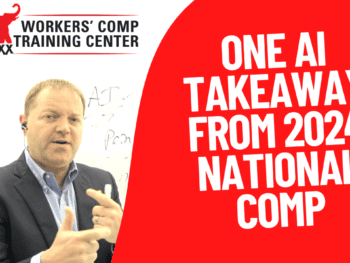I am reading the ProPublica Report with great interest because there are many things I agree with. After reading all the press brouhaha over this report however, I still regard the high cost of workers compensation (for those companies which do have high costs) mostly as a management problem
Click Link to Access Free PDF Download
The companies I see — which are the ones that have huge problems — are clueless about workers comp. They turn their claims and injury process over to their claims administrator or carrier, hardly participating in the process, then they blame the TPA or carrier when costs go up even though they have done nothing internally to manage safety or injuries.
These companies never budget for workers’ comp management, don’t staff the risk department (if there even is a “department”) properly. THAT would cost money and our headcount would increase, they say. Often if they do have staff, they do not allow, encourage or require the staff to attend conferences, seminars or join organizations or purchase resources. THAT would cost money, they say.
Sometimes their brokers offer to help by providing consulting resources, and the companies with high workers comp costs do not see the merit in such an approach. I worked with a major entertainment facility, speaking with them once per week, on behalf of their broker, hoping to gain insight. I offered to “consult” with them since I am a consultant, getting to the root of the problem, finding the cost drivers, and fixing them is what I do. They did not need a “consultant”. Then, one day I said I could “help them develop their training program” and they accepted instantly! I had used the wrong word — they needed “training help” not “consulting help”. Within months the high cost of their workers compensation program went down to almost zero. Problem solved.
Several things employers can do, but usually don’t are:
1. Contact employees within a week or two after the injury to do a SURVEY of their medical and claims adjuster experience. Speak to them via phone. Just like one would ask a good customer about their experience, Jennifer Christian, MD’s, Webility Corp Staff, contacts employees to find out if each injured worker felt their care was poor, fair, good, excellent. Often poor treatment by medical providers and callous indifference by adjusters causes employees to become angry, seek counsel or even delay recovery due to lack of expertise during the initial treatment experience.
2. Have claims reviewed periodically by an independent auditor with a MEDICAL PROVIDER on the team. Only an MD is qualified to read the medical reports to determine whether treatment was appropriate and sufficient, whether alternate causation has been considered, and whether aggressive and excellent (yes, perhaps MORE expensive) treatment has been provided. Make sure adjusters are not using UR to deny care. Audit, audit, audit. Care, care, care.
Do WEEKLY Roundtables with your TPA. E.G. Every Friday discuss 10 claims, etc. Don’t wait until claims reach $25,000. Discuss them when they are small, BEFORE they get astronomical.
3. Retain an MD to be part of your claims team. This can be an onsite MD part-time or full-time who also speaks with treating physicians and injured employees. Adjusters and nurses do not know “medicalese”. Applause to those insurers who have MD’s on staff BUT employers still need to have their own medical advisors on the team. Employers often forget we are talking about MEDICAL INJURIES, not simply “claims”.
4. Assess the key cost drivers of your workers compensation costs. 9 out of 10 times employers misdiagnose the cause of their high workers compensation costs. In one case, the employer was ready to fire the insurance company because “they thought” there was too much nurse case management. Upon more detailed analysis, including an independent review by claims experts and an MD, we found the claims were handled well 98% of the time. The cause of the problem was mis-identified.
FREE DOWNLOAD: “Step-By-Step Process To Master Workers’ Comp In 90 Days”
The REAL problem was a lack of a post injury response at the time of injury — employees and supervisors did not have steps to follow within the first 24 hours after the injury. We then held 19 training sessions over 3 weeks to improve best practices related to rapid medical care and RTW/SAW (return to work/stay at work) in this mega-entertainment theme park. The workers’ compensation costs dropped 20% in a year-over-year comparison of total incurred losses with the previous 12 month period.
5. There are no tools to guide employees and supervisors. In the above case, we provided: employee brochure, physician brochure, wallet cards in English/Spanish for supervisors and employees, and other tools.
6. And, MOST importantly, PROVIDE the BEST QUALITY MEDICAL CARE available. Yes, even if it’s more expensive. Pennywise is pound foolish. Get the best, not the cheapest. Pay the doctor MORE to spend more time with your injured employees, not less time.
7. Establish bundled pre-approval of care in Account Instructions so UR (utilization review) is not necessary. E.G. “All PTP (primary treating physician) treatments and up to 5 visits to specialists is pre-authorized by insured. All testing requisitioned by PTP and specialists including PT and MRIs is to be approved; do NOT submit to UR. If you strongly believe treatment or testing is unwarranted, contact the insured’s Medical Director before denying request.”
If you don’t manage and monitor it, the process (any process, not only workers’ compensation) will not work well.
It’s time for employers to become involved in their own business! The first step is assessing the problem at YOUR company, not the industry in general or another company, but get that mirror out and have a look. You are most likely looking at the problem.
END
Similar strategies appear in our book at www.WCManual.com or call me at ![]() 860-786-8286 about assessing your situation or (re)training your operations.
860-786-8286 about assessing your situation or (re)training your operations.
Join Our LinkedIn Workers Compensation Roundtable
Receive our Newsletter
Author Rebecca Shafer, JD, President of Amaxx Risk Solutions, Inc. is a national expert in the field of workers compensation. She is a writer, speaker, and publisher. Her expertise is working with employers to reduce workers compensation costs, and her clients include airlines, healthcare, printing/publishing, pharmaceuticals, retail, hospitality, and manufacturing. She is the co-author of the #1 selling book on cost containment, Workers Compensation Management Program: Reduce Costs 20% to 50%. Contact:[email protected].
Author Michael B. Stack, Principal, Amaxx Risk Solutions, Inc. He is an expert in employer communication systems and helps employers reduce their workers comp costs by 20% to 50%. He resides in the Boston area and works as a Qualified Loss Management Program provider working with high experience modification factor companies in the Massachusetts State Risk Pool. He is co-author of the #1 selling book on cost containment, Your Ultimate Guide To Mastering Workers Comp Costs www.reduceyourworkerscomp.com. Contact: [email protected].
© 2015 Amaxx Risk Solutions, Inc. All rights reserved. For permission to reprint, copy, or even to rephrase, contact Michael Stack at mstack@
SALES TO PAY FOR ACCIDENTS CALCULATOR: http://reduceyourworkerscomp.com/sales-to-pay-for-accidents-calculator/
WC GROUP: http://www.linkedin.com/groups?homeNewMember=&gid=1922050/
Do not use this information without independent verification. All state laws vary. You should consult with your insurance broker, attorney, or qualified professional.
FREE DOWNLOAD: “Step-By-Step Process To Master Workers’ Comp In 90 Days”















This is an excellent blog to read! I just received the 2019 Ultimate Guide, and have already put practices to use in my Workman’s Compensation case updates and 2020 plan. This came at a perfect time, and during celebration of my first Expert Witness case settlement. It feels like a reward getting Rebecca Shafer and Michael Stack’s training today.